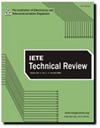MIMO超宽带双陷波天线的设计与研究
IF 1.8
4区 计算机科学
Q2 ENGINEERING, ELECTRICAL & ELECTRONIC
引用次数: 0
摘要
介绍了一种印刷单极超宽带天线。它由一个斜形散热器和一个锥形接地面组成。研究了辐射体与地平面的逐渐变细可以增强阻抗匹配,从而获得更宽的阻抗带宽。实验结果表明,该天线在2.6 ~ 27.27 GHz范围内阻抗带宽达到164.9%。此外,为了防止超宽带(UWB)范围内通信系统造成的干扰,在Wi-MAX (2.7-4 GHz)下进行双频抑制。和x波段(8.5 - 12ghz)分别通过在散热器和馈线上刻蚀一个h形和两个背靠背的c形缺口来引入。测量结果表明,在2.41 GHz到2.6 GHz的范围内,两个槽都能有效地抑制所需的频段,并且低频边缘有较小的偏移。此外,本文还展示了该天线在双元MIMO系统中的应用,该系统采用领结解耦结构来提高隔离度。发现解耦结构的存在使隔振性提高了60%。为了描述分集性能,计算了诸如分集增益(DG)、包络相关系数(ECC)、信道容量损耗(CCL)和平均有效增益(MEG)等参数,并发现它们都在可接受的范围内。本文章由计算机程序翻译,如有差异,请以英文原文为准。
The Design and Investigation of a Super Wideband Antenna with Dual-Band Notch Characteristics for MIMO Application
A printed monopole super wideband (SWB) antenna is presented in this paper. It consists of a beveled-shaped radiator and a tapered ground plane. It is investigated that tapering of the radiator and ground plane enhances the impedance matching and results in broad impedance bandwidth. The experimental result depicts that the antenna achieved 164.9% impedance bandwidth from 2.6 to 27.27 GHz. Furthermore, to prevent the interference caused by communication systems within the ultra-wideband (UWB) range, dual-band rejection at Wi-MAX (2.7–4 GHz). and X-band (8.5–12 GHz) are introduced by etching an H-shape and two back-to-back C-shaped notches in the radiator and feedline, respectively. The measured result demonstrates that both slots effectively reject the desired frequency bands with a small shift in the lower frequency edge from 2.41 to 2.6 GHz. In addition, the proposed antenna application is shown in the two elements MIMO system where a bowtie decoupling structure is utilized to improve the isolation. It is found that the presence of a decoupling structure improves the isolation by up to 60%. To characterize the diversity performance, parameters such as Diversity Gain (DG), Envelop Correlation Coefficient (ECC), Channel Capacity Loss (CCL), and Mean Effective Gain (MEG) are calculated and all are found in the acceptable limit.
求助全文
通过发布文献求助,成功后即可免费获取论文全文。
去求助
来源期刊

IETE Technical Review
工程技术-电信学
CiteScore
5.70
自引率
4.20%
发文量
48
审稿时长
9 months
期刊介绍:
IETE Technical Review is a world leading journal which publishes state-of-the-art review papers and in-depth tutorial papers on current and futuristic technologies in the area of electronics and telecommunications engineering. We also publish original research papers which demonstrate significant advances.
 求助内容:
求助内容: 应助结果提醒方式:
应助结果提醒方式:


